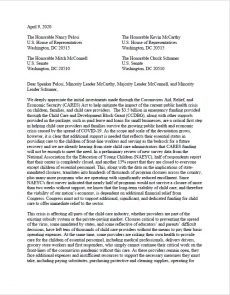Abortion rights, women of color, and LGBTQIA+ people are under attack. Pledge to join us in fighting for gender justice.
The National Women’s Law Center led an effort to generate nearly 500 sign-ons from providers and advocates across the U.S. in support of asking Congress to provide at least $50 billion in dedicated child care funding. As the letter lays out, child care is an essential need for millions of children and families, and it will continue to be the backbone of our economy both during and after this crisis, but only if additional funding is provided to keep it afloat.
The need for a functioning child care system is critical for getting families back to work and school as we recover from this crisis. The profound gaps in our child care infrastructure already cost American families and the economy about $57 billion each year in lost earnings, productivity, and revenue. If Congress does not take action to ensure that child care providers can serve essential workers now, and survive until this crisis ends, so that they and families around the country can return to work, that loss will grow exponentially, impeding the full recovery of the American economy. In addition, beyond the immediate needs to keep the industry afloat during this crisis, we must rebuild our system to ensure that all families have access to high-quality, affordable child care provided by educators who are paid what they deserve and supported. A well-resourced, equitable child care system is essential for our economic recovery. We must invest the public dollars and pursue the changes needed to realize this promise.
In order to protect and preserve our child care system for child care providers, workers, and the children and families they serve, the letter urges lawmakers to provide at least $50 billion in aid targeted to the child care sector. In addition, as we look ahead to our eventual recovery, Congress should also advance solutions that comprehensively address the gaps in our child care system that contributed to these needs.

